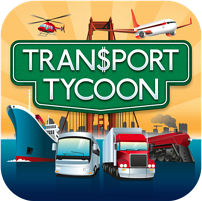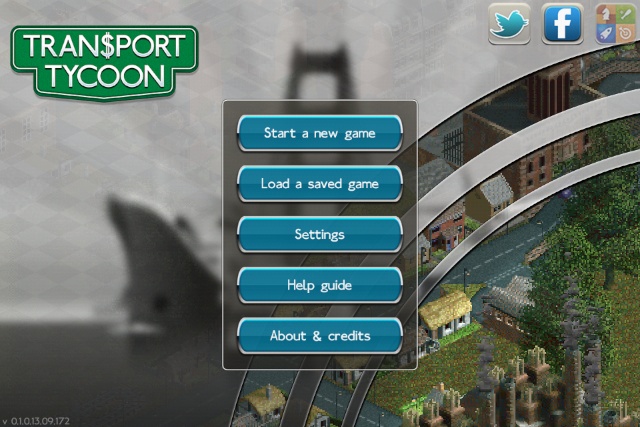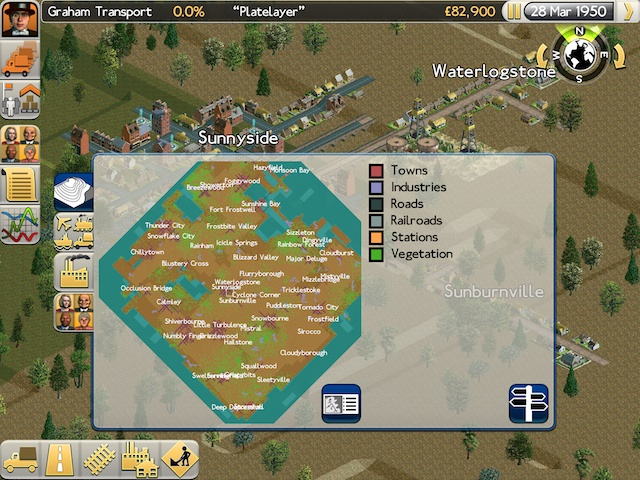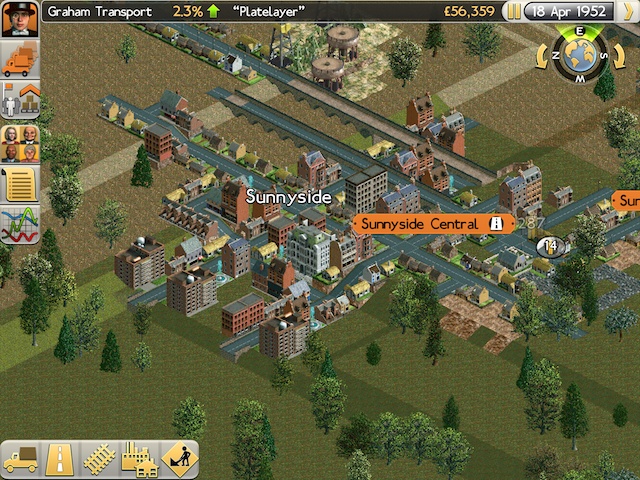
|
By Graham K. Rogers

Transport Tycoon was one of my all time favourite games when I had a PC. While the original SimCity had a certain appeal, Transport Tycoon was one that grabbed me the most. The game following was so great that for years after the program disappeared from the stores, there were clubs, newsgroups, and it was also possible to install an old version using Open Source software. That worked on Macs too.
While the creator of the original game, Chris Sawyer, went on to more success with Roller Coaster Tycoon, it was always Transport Tycoon that was remembered most fondly. Other developers came out with similar games, but there was never the overall creative experience that users wanted: developing and controlling a small word inside a computer.
After many years (and just as many rumours), it was announced a few months ago that, by arrangement with Chris Sawyer, the game was to be reintroduced for the iPad. This week, developers 31X with Origin 89 Technologies, released versions of Transport Tycoon for iOS (iPad, iPhone and iPod touch) and Android.
As soon as the game became available (several hours before the US release), I downloaded a copy and installed it on my iPad and iPhone. My first impressions were that the new game has been faithfull to the original, with the design of landscape and buildings in the same style as the PC original. In those days, the graphics were considered to be of high quality. These days, with no criticism intended, they are delightfully quaint, helping to retain the sense of the original.
I was surprised to see that the game would install on the smaller iOS devices, so tried it first on the iPhone 4S I use currently, then on the iPad. While the display on the iPhone is every bit as beautiful as on the iPad, the smaller screen size did not feel right, even though I have played such games as SimCity on the iPhone (briefly) and on the even smaller screen of a Palm c130 I had a few years back.
I started playing Transport Tycoon on the iPhone by running the basic game after viewing one of the tutorials. I found it was fairly difficult to envisage the geographical areas within the game that I was working in. A larger map of the country is available with one click, but the small patch that users can see - even when using the pinch to zoom out - did not give me that overview that the PC game had allowed.
The artifical scope of the game is too large for such a medium to be played in a satisfactory way. With the game installed on the PC, there was enough screen room to view the game - as if from a light aircraft - and manage the scenario. In that older form, too, the menu systems allowed a clearer working space.
With a touch screen, the menus are opened onscreen when needed, but some artifacts are always shown, so the area with the phone installation is restricted, especially with the relatively large menu icons. Actually using the menu system - for example to set up a basic bus route on already-existing roads - needs access to several separate screens as the bus stops are built, bus(es) bought, route set and vehicle started. The tutorials here are a blessing.
To try and handle the iPhone game better, I connected mine to a 20" LCD monitor. Viewing it this way, gave me a better view of the working area, but with controls from a touch screen rather than a keyboard driven menu system, there were still minor problems at this early stage.
The original game was one that I never kept learning, and each time it was played, there would be a different outcome in terms of design, transport media developed and outcome. That after all is the essence of a great game. Like golf, the user can never really win. I anticipate a longer learning curve than I had expected, particularly with the different displays and handing that the menus and commands require.

On the iPad, the screen size made things much easier right away. The installation is identical to that on the iPhone with 5 experience levels, from Beginner to Expert. The lowest level has 3 tutorials, which are excellently made and a must if a user is to get the most out of the game. "Beginner" also has 3 basic games, Weatherworld, Boulder Breakers and Sandbox Settler. The "Easy" level has 7 scenarios, Medium 14, Hard 12, and Expert 10. These are a mix of US, British and European landscapes, with desert thrown in for good measure.
Selecting any game brings up a keyboard on which a user types a name. The keyboard is not the usual iOS type, but a unique design for this game. Loading the scenario, there is a view of the countryside in the center of the game area. A map of the full scene may be viewed by tapping on the globe icon, top right.

By tapping on the icons at the side and bottom of the map, different view options are displayed. The map itself, like the working screen, may be zoomed (in or out) using the pinch - two fingers, open or close. Tapping on the globe again closes the map.
There are more immediate menu options, all in graphic form to the left and bottom left of the screen. Tapping each one reveals current information. Tapping again closes the data panel. These are (from the top):
- Company information, including a picture of the CEO (this can be changed). It also has a series of submenus that detail other facts about the running of the company, like vehicles owned, balance sheet, finances and statistics.
- A vehicles menu, showing the numbers owned (trucks, buses, trains, trams - new with this game - aircraft and ships)
- Stations - as transport facilities, including depots and airports, are added, they are listed here
- Companies. With the basic game, there is a single company; but with different levels, other companies are created by the game and compete with the player
- Past events lists the fictitious history of the area - particularly commercial developments that a player should react to for the best results
- Performance indexes shows a series of charts - financial, cargo, rates - that indicate how the company is doing.

At the bottom left the menus are concerned with infrastructure. The player needs to work with several of these, switching back to company menus at times, to build and then operate the transport systems. These are:
- Purchase vehicles - trucks, buses, trains, trams, aircraft and ships. Those available change with the passage of time
- Road Building - although there are some roads within the small towns, to connect these requires investment and construction of highway, bridges and passenger stops
- Track Building has normal track and 3rd rail systems, bridges, signals and stations
- Construction of airports and docks was in the original game, but for me a new feature is the ability to invest in new industries (brewery, factory, food plant, steel mill, oil refinery). These produce output that can be carried as goods to other locations, but also need input for their operations. It is this balance that can make or break a transport company. In the game, that is.
- Terraforming allows the user to demolish buildings, adjust land levels up or down, raise or lower water levels, and plant forests one tree at a time. There are about 30 trees available, including copper beech, maple and oak.
It is these actions that are most different from the original game. Whereas with a PC, an area could be adjusted with a mouse, with the iPad (or iPhone), using the touchscreen just moves the landscape about. Instead, there are additional controls that indicate where an effect should be applied and the direction. This made it less instinctive than I had expected. I will need time to adjust and learn.
What I also found less intuitive was giving the orders to a vehicle. These are necessary to make sure a bus or train stops at the right place and in the right order of destinations, so that passengers or goods are not carried halfway round the world. In the PC game, the orders were added with a mouse click. On the iPad and iPhone this required a series of menu steps and clicks that did not seem to follow logically, despite me having viewed a tutorial in which this was explained.
It is certainly much easier to play Transport Tycoon on the iPad than on the iPhone, but that is not a loss for me as I had initially expected the game to be available only for the larger device. I will now be able to use the iPhone for the (very necessary) practice I need to sharpen my skills and make this work as it did so well on the last PC I ever owned.
See also:
Transport Tycoon Released for iOS Devices (and Android)
Graham K. Rogers teaches at the Faculty of Engineering, Mahidol University in Thailand where he is also Assistant Dean. He wrote in the Bangkok Post, Database supplement on IT subjects. For the last seven years of Database he wrote a column on Apple and Macs.
|

|







